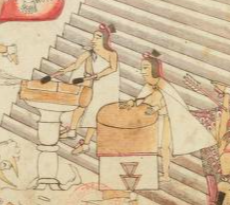huehuetl (Azca29)
This painted black-line drawing is an unglossed iconographic example of a standing wooden drum (which we are labeling huehuetl here). A man in a three-quarter view and wearing a white cape is playing the drum. The drummer plays the drum with his hands. He has a clump of hair tied with a red (probably leather) thong on top of his head. This style might be a tzontli. The legs of the drum have two triangles cut out, and these gaps have red borders.
Stephanie Wood
The huehuetl drum sometimes had a jaguar pelt covering the top, as can be seen in two of the glyphs below. The design of the legs are also borne out by these glyphs. Several examples show the use of hands in beating this standing drum. People who played this drum also often sang or chanted.
Stephanie Wood
post-1550, possibly from the early seventeenth century.
Jeff Haskett-Wood
tambores, música, madera, tecnología
huehue(tl), standing drum, https://nahuatl.wired-humanities.org/content/huehuetl
el tambor de pie
Stephanie Wood
The Codex Azcatitlan is also known as the Histoire mexicaine, [Manuscrit] Mexicain 59–64. It is housed in the Bibliothèque Nationale de France, and hosted on line by the World Digital Library and the Library of Congress, which is “unaware of any copyright or other restrictions in the World Digital Library Collection.”
https://www.loc.gov/resource/gdcwdl.wdl_15280/?sp=29&st=image
The Library of Congress is “unaware of any copyright or other restrictions in the World Digital Library Collection.” But please cite Bibliothèque Nationale de France and this Visual Lexicon of Aztec Hieroglyphs.




